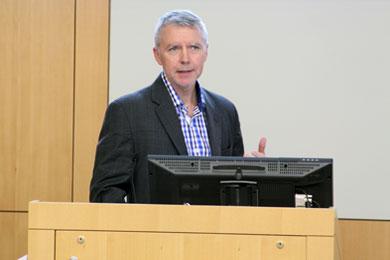SOP’s Kane to Test New Biomarkers of Fetal Alcohol Spectrum Disorders
Collaboration with University of New Mexico College of Pharmacy will employ expertise of the School’s Mass Spectrometry Center.
By Malissa Carroll
September 10, 2014
Maureen Kane, PhD, assistant professor in the Department of Pharmaceutical Sciences (PSC) at the University of Maryland School of Pharmacy and co-director of the School’s Mass Spectrometry Center, has received a three-year, $75,849 National Institutes of Health (NIH)/National Institute on Alcohol Abuse and Alcoholism (NIAAA) R15 grant subaward from the University of New Mexico College of Pharmacy to use mass spectrometry to evaluate and measure the presence of biomarkers for exposure to alcohol during pregnancy in meconium – an infant’s first stool.
Her findings will determine if the biomarkers can reliably identify infants who were prenatally exposed to alcohol, as well as help other researchers determine how exposure to alcohol interacts with exposure to environmental heavy metals found in mine wastes to affect birth outcomes and development in children during the first year of life.
“This project is an excellent example of how the tools and expertise available through the School’s Mass Spectrometry Center have increased our opportunities to collaborate with researchers across the University of Maryland, Baltimore (UMB) and beyond,” says Kane. “Research that examines how prenatal alcohol exposure interacts with exposure to other environmental toxicants is limited. Using the Mass Spectrometry Center’s state-of-the-art instrumentation, we aim to quantify reliable biomarkers that will better detect an infant’s risk for neurodevelopmental delays among newborns who were not only affected by prenatal exposure to alcohol, but to other toxic substances in the environment as well.”
For the study, titled “Interactive Effect of Environmental Exposures and Alcohol in the Navajo Birth Cohort,” Kane will use mass spectrometry to measure the presence of three biomarkers — any biological molecule found in an individual’s blood or bodily fluids and tissues that indicates the presence of disease, infection, or environmental exposure — in the meconium of more than 300 newborns from the Navajo Nation: fatty acid ethyl esters (FAEEs), ethyl glucuronide (EtG), and ethyl sulfate (EtS).
Meconium, which consists of substances ingested while an infant was in utero, is routinely used in newborn screenings to determine whether he or she was exposed to illicit drugs. The study will be led by co-principal investigators Johnnye Lewis, PhD, professor in the Department of Pharmaceutical Sciences at the University of New Mexico College of Pharmacy and Director of the Community Environmental Health Program, and Ludmila Bakhireva, MD, PhD, MPH, associate professor in the Department of Pharmacy Practice at the College of Pharmacy. The meconium samples will come from Lewis’s Navajo Birth Cohort Study.
“Because the consumption of alcohol during pregnancy affects a number of additional outcomes that we want to measure in the Navajo Birth Cohort Study, our research team knew that it would be important to support a project that would produce an independent measure of alcohol consumption,” says Lewis. “Dr. Kane’s knowledge of mass spectrometry and previous experience with biomarkers of prenatal exposure to alcohol will not only contribute to the goals of our project, but will also allow our team develop a control for co-exposures to help determine whether any interactions exist between alcohols and metals exposure.”
“This project represents a unique partnership between two schools of pharmacy and the tribal community,” adds Bakhireva. “Dr. Kane’s expertise in mass spectrometry will be crucial in helping us to accurately assess prenatal alcohol exposure in a study population that is largely underrepresented in research. Ultimately, our goal is to reduce health disparities and improve reproductive health outcomes among Native Americans.”
There are more than 1,000 abandoned uranium mine waste sites across the Navajo Nation, and more than 10,000 in the western United States. The Navajo Birth Cohort Study was launched in response to community members and the Navajo Nation’s concerns about how exposures to these heavy metal mixtures could affect the health of their children. “If successful, our findings could lead to earlier recognition of risk, which would allow for earlier interventions that could improve developmental outcomes for those children affected by these exposures,” says Kane.



